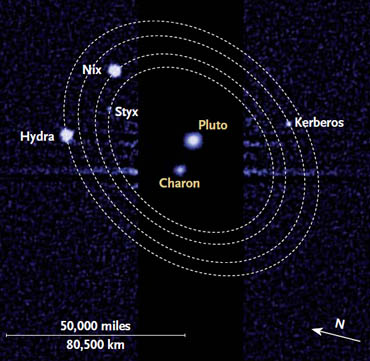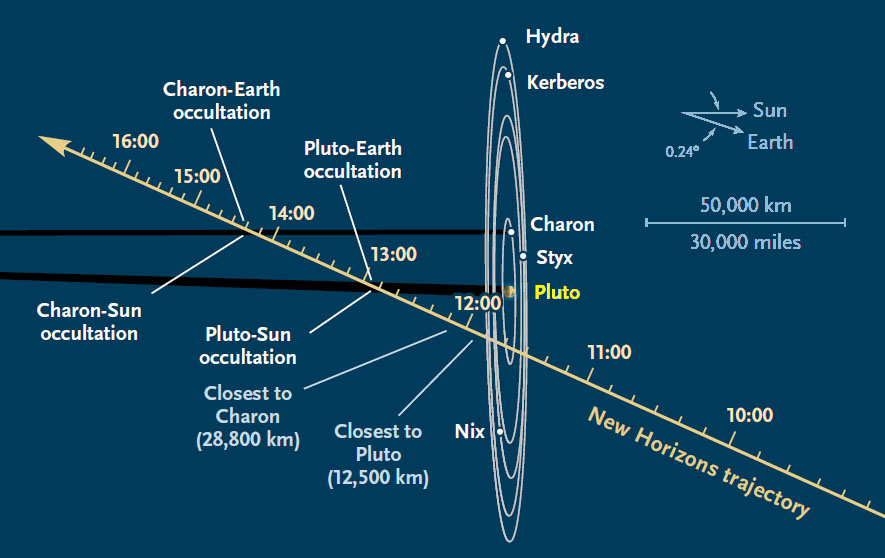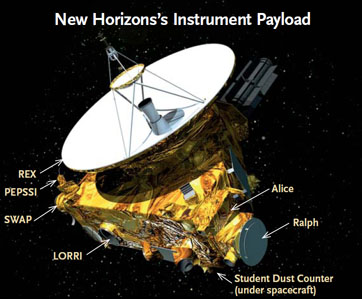In his third "insider blog" about the New Horizons mission, principal investigator Alan Stern offers a look at the timetable for getting results from the historic flyby.

NASA / ESA / M. Buie
It sounds like science fiction, but it’s not: NASA’s New Horizons spacecraft is on final approach to the Pluto system! After 113 months in flight, the fastest spacecraft ever launched is now barely 30 days from its destination. Closest approach of the flyby occurs on July 14th at 11:50 Universal Time.
I’m writing a series of insider blogs about the mission for Sky & Telescope, and in this third one, I want to give you a feel for what images and other data sets we’ll be receiving on the ground during the encounter.
As background to that, I should explain first that New Horizons was built to be very, very effective at taking and storing large amounts of data as it zips past Pluto and its five moons at 13.8 km (8.6 miles) per second. This was accomplished by providing the capability for up to five of the seven science instruments to be operating at any one time, and by providing two large recorders for data storage during encounter. As a result of these and other design features, New Horizons will take about 100 times as much data during the flyby as it can send back on a typical day. Given this, and given that we have to share NASA’s Deep Space Network of communications stations with other missions, getting all of the Pluto system observations back on Earth will take the rest of 2015 and most of 2016.

S&T: Gregg Dinderman / Source: NASA
That in turn means that New Horizons, long after it's passed by Pluto, will continue to return new data and discoveries — to you — and to our science team, for a very long time — almost as if it were still at the planet, gathering data.
But even though we'll be receiving a steady stream of images, spectra, and other data for some 16 months after July’s flyby, many images and other observations will be returned during the close-approach operations spanning July 4th to July 20th.
The table below shows you just the images (and their expected resolutions) that we expect to receive each day during that 2½-week-long window. Keep in mind that Pluto’s diameter is almost 2,400 km (1,500 miles), so for example, a 40-km/pixel image should put about 3,000 pixels on Pluto's disk and a 10 km/pixel image would put about 45,000 pixels on its disk. Also keep in mind that as Pluto and its satellites rotate as we approach, we’ll not only be getting higher and higher resolution, but we’ll also be seeing new terrains coming into view. (In the last column, P = Pluto, C = Charon, N = Nix, and H = Hydra.)
|
Receipt of New Horizons' Images |
||||
| July | Camera | Image type | Resolution (km/pixel) |
Target(s) |
| 4 | LORRI | panchromatic | 63 | P,C,H |
| 5 | LORRI | panchromatic | 55 | P,C,N,H |
| MVIC | color | 250 | P,C | |
| 6 | LORRI | panchromatic | 51 | P,C,N,H |
| 7 | LORRI | panchromatic | 44 | P,C,N |
| 8 | LORRI | panchromatic | 39 | P,C,H |
| 9 | LORRI | panchromatic | 32 | P,C,H |
| 10 | LORRI | panchromatic | 27 | P,C,N,H |
| 11 | LORRI | panchromatic | 20 | P,C,N,H |
| 12 | LORRI | panchromatic | 14 | P,C |
| 13 | LORRI | panchromatic | 4 | P |
| LORRI | panchromatic | 7 | C | |
| MVIC | color | 28 | P,C | |
| 14 | (no images sent) | — | — | — |
| 15 | LORRI | panchromatic | 3.9, 0.4 | P |
| LORRI | panchromatic | 2.3 | C | |
| LORRI | panchromatic | 3.2 | H | |
| LORRI | panchromatic | 2.9 | N | |
| 16 | LORRI | panchromatic | 0.4 | C |
| MVIC | — | 4.9 | P,C | |
| 17 | LORRI | panchromatic | 2.2 | P |
| LORRI | panchromatic | 1.2 | H | |
| 18 | LORRI | panchromatic | 1.8 | P |
| MVIC | color | 3.1 | N | |
| 19 | (no images sent) | — | — | — |
| 20 | LORRI | panchromatic | 0.4 | P |
And here's a second table that shows some of the other data types that the spacecraft will be sending home each day.
|
Other New Horizons Observations |
||||
| July | Atmospheric observations | Surface-composition maps | Plasma data |
Other |
| 4 | — | — | Yes | — |
| 5 | — | — | Yes | — |
| 6 | — | — | Yes | — |
| 7 | — | — | — | Imaging only |
| 8 | — | — | — | Imaging only |
| 9 | — | — | — | Imaging only |
| 10 | — | — | — | Imaging only |
| 11 | — | — | — | Imaging only |
| 12 | Airglow spectra | Pluto (156 km/pixel) | — | — |
| 13 | Airglow spectra | Pluto & Charon (132 km/pixel) |
Yes | — |
| 14 | — | — | — | — |
| 15 | Airglow spectra and Pluto ultraviolet occultation |
— | Yes | Thermal, radar |
| 16 | — | Pluto (8.9 km/pixel) | — | — |
| 17 | Airglow and nightglow spectra | — | — | — |
| 18 | Radio occultation | Charon (8.7 km/pixel) | — | — |
| 19 | — | Pluto (8.9 km/pixel) | — | — |
| 20 | — | — | — | Imaging only |

NASA / JHU-APL
As you can see, there’s a wide variety of data coming down in July to reveal many kinds of details about Pluto, Charon, and Pluto’s small satellites. We'll also be searching for rings, mapping surface compositions, studying Pluto’s atmosphere, and measuring its surface temperature and radar reflectivity.
By the time July is over, we’ll have a pretty good sampling of the many kinds of data New Horizons obtained when close to the Pluto system. But the real deluge that fills in the details — and which comprises the other 99% of the data taken — will have to wait for the long downlink that begins after the flyby.
Planetary scientist S. Alan Stern of the Southwest Research Institute is the Principal Investigator of NASA's New Horizons mission to Pluto. He is writing a series of blogs for Sky & Telescope before and during the spacecraft's historic encounter.
 6
6
Comments
June 3, 2015 at 1:12 pm
Is the speed of 13.8 km/s relative to Pluto or Earth? I thought the spacecraft was travelling much faster than that relative to earth.
You must be logged in to post a comment.
J. Kelly Beatty
June 12, 2015 at 3:03 pm
it's with respect to Pluto.
You must be logged in to post a comment.
anobium
June 5, 2015 at 11:07 am
When you write "images that we expect to receive…" does "we" mean you folks or "us", the general public? If it doesn't mean the general public, what is a reasonable schedule for the rest of us? Thanks for what you have done and what you will be doing.
You must be logged in to post a comment.
Duane-Smith
June 6, 2015 at 11:00 am
With so much of the data being stored for later transmission, how will the team be monitoring the instruments to check if there are any problems in the data collection?
You must be logged in to post a comment.
Frank-Schmidt
June 6, 2015 at 6:57 pm
My question is: At what rate will Pluto's motion appear against the back ground from the space craft near closest approach (like in degrees per minute)?
You must be logged in to post a comment.
Graham-Wolf
June 7, 2015 at 7:08 pm
Almost there! A huge "high-five" to Alan and his awesome team. What an effort!
Let's not be impatient folks and keep those unrealistic expectations firmly under control. This mission is the toughest yet attempted. It's taken nearly 10 years to get "New Horizons" to Pluto, and all's well, so far. I'm cautiously optomistic. Best wishes:- Alan, for a fully successful Mission. The world is watching and proudly cheering you folk onwards. If it takes another year or two to fully download the tsunami of images and data, that's fine by me... "data capture" is all important, data transmission back to Earth can take as long is is safely required to complete.
Have a great day on the 14th at closest encounter.... it will be 11:50pm NZST here in Lower Hutt.
Graham W. Wolf (NZ)
You must be logged in to post a comment.
You must be logged in to post a comment.